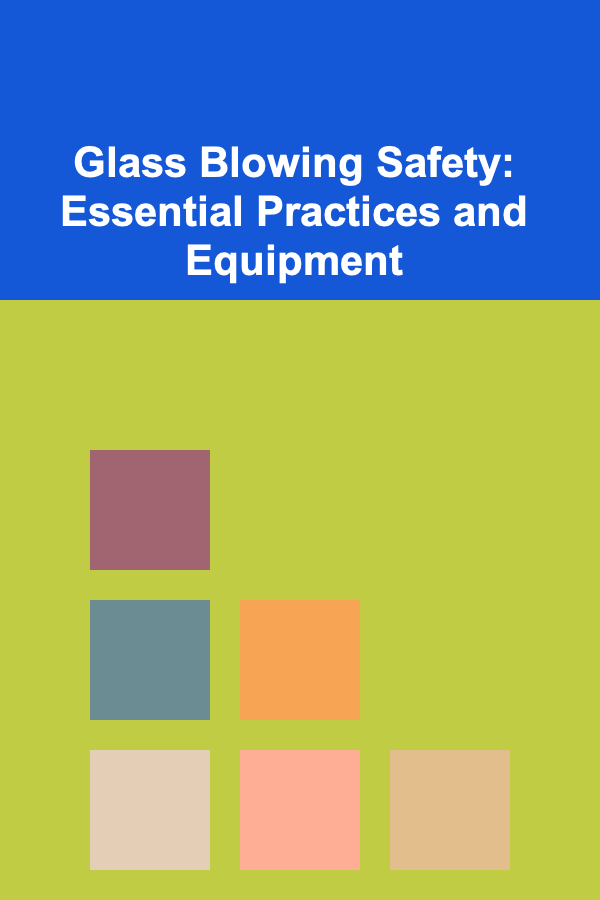
Glass Blowing Safety: Essential Practices and Equipment
ebook include PDF & Audio bundle (Micro Guide)
$12.99$11.99
Limited Time Offer! Order within the next:

Glass blowing is a fascinating art form that has been practiced for centuries. It involves creating intricate designs and functional pieces of art by heating glass until it becomes soft and pliable, allowing the artist to shape it using a variety of tools. While the process is highly creative and rewarding, it also involves significant risks, including high temperatures, sharp objects, and heavy machinery.
For both beginners and seasoned professionals, understanding and adhering to safety protocols is critical to preventing accidents and ensuring a safe working environment. In this article, we will explore the essential safety practices and equipment necessary to protect both the artist and the surrounding environment during glass blowing.
Understanding the Hazards in Glass Blowing
Before diving into the safety practices and equipment, it's important to understand the primary hazards involved in glass blowing. Some of the key risks include:
1. High Temperatures
- Glass is typically heated in a furnace to temperatures between 2,000°F and 2,300°F (1,093°C to 1,260°C). At these temperatures, the glass becomes molten and can cause severe burns if mishandled.
2. Sharp Tools and Glass
- Glass blowing involves handling sharp tools such as blowpipes, punty rods, shears, and chisels. Additionally, the glass itself, once cooled, can be very sharp and dangerous.
3. Heavy Equipment
- Glass blowers often work with large furnaces and kilns, which can pose risks of fire or injury due to their size and weight.
4. Inhalation of Fumes
- Some glass blowing materials, such as certain types of metal oxides, can release toxic fumes when heated. These fumes can be harmful if inhaled over extended periods.
5. Physical Strain
- Glass blowing often requires prolonged periods of standing, bending, and lifting, which can lead to physical strain and injury if proper ergonomics are not observed.
Understanding these risks is the first step toward mitigating them. By implementing safety practices and using the right equipment, you can reduce the potential for accidents and injuries.
Essential Safety Practices
Safety practices in glass blowing focus on minimizing exposure to these risks and ensuring that the work environment is safe. Here are some essential safety practices:
1. Proper Training and Supervision
- Glass blowing is a skill that requires both theoretical knowledge and practical experience. Proper training from a skilled instructor is essential, especially for beginners. It's also important to practice in a well-supervised environment until you are fully comfortable with the equipment and techniques.
2. Workplace Organization
- Keep your workspace clean and organized. Glass blowing requires a lot of equipment, and clutter can lead to accidents. Ensure that all tools and materials are stored properly when not in use to avoid tripping hazards or accidental burns.
3. Maintain Safe Distances
- Always maintain a safe distance from others when using hot equipment, especially in a shared studio environment. Glass blowing involves the use of intense heat and heavy machinery, so it's important to respect personal space to avoid collisions or burns.
4. Be Aware of Fire Hazards
- Glass blowing is a high-heat process that presents a significant fire hazard. Make sure to have fire extinguishers and blankets readily available in the studio. Never leave hot glass or equipment unattended, and be sure to properly cool down equipment after use before storing it.
5. Proper Ventilation
- Ensure that your studio is well-ventilated, especially if you are working with materials that emit toxic fumes. Many glass artists use lead, cadmium, and other materials that can release hazardous fumes when heated. A fume extraction system or proper ventilation will help prevent inhalation of these fumes.
6. Wear Protective Clothing
- Always wear proper protective clothing when working with hot glass. This includes:
- Heat-resistant gloves: Special gloves made of leather or kevlar help protect your hands from heat.
- Long sleeves and pants: To protect your skin from burns, wear long sleeves and pants made of natural, non-synthetic fibers (such as cotton).
- Closed-toe shoes: Avoid sandals or open-toe footwear, as they can leave your feet vulnerable to hot glass spills or heavy equipment.
- Aprons: Protective aprons made of heat-resistant material can provide extra protection for your body, especially in the chest area.
7. Use Eye Protection
- Glass blowing can involve intense light, including infrared and ultraviolet rays that can harm your eyes. Always wear protective eyewear, such as safety goggles or a face shield, to protect your eyes from both heat and harmful rays. Specialized goggles designed for glassblowers are available and can be used to filter out harmful light.
8. Proper Tool Handling
- Tools used in glass blowing, such as blowpipes, punty rods, and shears, can be heavy and sharp. Always use tools that are in good condition and make sure they are properly maintained. Handle them carefully to avoid cuts, burns, or accidental drops.
9. Know Emergency Procedures
- Every glassblower should be familiar with emergency procedures in case of an accident. This includes knowing how to:
- Use a fire extinguisher.
- Evacuate the area in case of fire or chemical spill.
- Treat burns and cuts properly (e.g., using cold water for burns or applying bandages for cuts).
10. Stay Focused and Alert
- Glass blowing requires full attention. Never work while distracted or tired, as this can lead to accidents. If you need to take a break, do so, and return to your work with a clear and focused mind.
Essential Glass Blowing Equipment
While safety practices play a crucial role in preventing accidents, using the right equipment is also essential for creating a safe glass blowing environment. The following is a list of essential equipment used in glass blowing:
1. Furnace and Kiln
- The furnace is used to melt the glass, while the kiln is used to anneal (cool) the glass slowly to prevent stress fractures. Both pieces of equipment reach extremely high temperatures, and it is vital that they are in good working order and properly maintained.
2. Blowpipe
- A blowpipe is a long, hollow metal tube used to gather molten glass from the furnace and blow air into it to shape the glass. It should be made of heat-resistant material and handled carefully to prevent burns.
3. Punty Rod
- A punty rod is a metal rod used to hold and manipulate a piece of glass while it is being shaped. It is often used in the final stages of glass blowing when the artist needs to attach a handle or move the glass from one place to another.
4. Shears and Cutters
- Shears are used to cut and trim hot glass, while glass cutters are used for scoring the glass before it is broken or shaped. Both should be kept sharp and in good working condition.
5. Gloves and Tongs
- Specialized heat-resistant gloves are essential for handling hot glass, and tongs are used to manipulate the glass and shape it during the blowing process. Tongs should be used to prevent direct contact with hot glass.
6. Cooling Racks and Tables
- After a piece of glass has been shaped, it needs to cool down in a controlled manner to avoid stress and cracking. Cooling racks and tables provide a safe surface to rest glass pieces while they are cooling.
7. Ventilation System
- A fume extraction system or ventilation fans are necessary to remove harmful fumes from the studio. This is especially important when working with glass that contains lead, cadmium, or other toxic substances.
8. Protective Eyewear
- As mentioned earlier, safety glasses or face shields should be worn to protect the eyes from both physical damage and harmful radiation. This equipment should meet the standards set by safety organizations.
9. Fire Extinguishers
- Given the high-temperature nature of glass blowing, having a fire extinguisher nearby is essential. Ensure that it is rated for both electrical and chemical fires.
10. First Aid Kit
- A well-stocked first aid kit should always be available to treat minor burns, cuts, or other injuries that might occur during the glassblowing process.
Conclusion
Glass blowing is a rewarding and beautiful art form, but it comes with inherent risks. By adhering to the essential safety practices outlined in this article and using the proper equipment, artists can create in a safe environment while minimizing the potential for accidents.
Whether you're a beginner just starting out or an experienced glassblower, safety should always be your top priority. Following these safety guidelines and using the appropriate tools will help ensure that your glass blowing experience remains creative and accident-free. Always remember that the key to success in glass blowing is not just in mastering the craft, but also in creating a safe, well-prepared workspace.
Reading More From Our Other Websites
- [Home Space Saving 101] How to Embrace Tiny Home Living: Space-Saving Strategies
- [Home Soundproofing 101] How to Block TV Noise in Your Room with Simple Soundproofing Solutions
- [Skydiving Tip 101] Wearable Tech in Skydiving: Smart Altimeters, GPS Trackers, and Future Innovations
- [Organization Tip 101] How to Create a Calm and Focused Atmosphere
- [Home Lighting 101] How to Use Smart Lighting to Save Energy and Create a Comfortable Living Environment
- [Star Gazing Tip 101] Mastering Night Sky Navigation: Tips for Aligning Your Telescope
- [Home Budget Decorating 101] How to Shop for Home Decor Without Going Over Budget
- [Home Maintenance 101] How to Maintain Your Home's Air Conditioning Unit
- [Beachcombing Tip 101] Best Advice for Interviewing Local Fishermen About Hidden Beachcombing Hotspots
- [Home Party Planning 101] How to Choose the Right Playlist for Your Home Party

How to Build a Retirement Planning Checklist for Emergency Funds in Retirement
Read More
How to Create a Reading Nook for Personal Growth Materials
Read More
How to Minimize Vacancy Time Between Tenants
Read More
How to Use Drawer Dividers for Better Organization
Read More
How to Use Fabric and Textiles to Add Holiday Spirit to Your Home
Read More
How to Create Printable Signs for School Events
Read MoreOther Products

How to Build a Retirement Planning Checklist for Emergency Funds in Retirement
Read More
How to Create a Reading Nook for Personal Growth Materials
Read More
How to Minimize Vacancy Time Between Tenants
Read More
How to Use Drawer Dividers for Better Organization
Read More
How to Use Fabric and Textiles to Add Holiday Spirit to Your Home
Read More